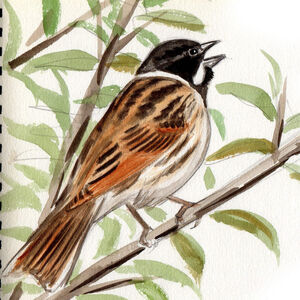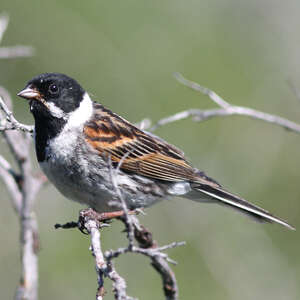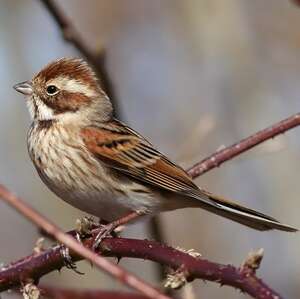Common Reed Bunting
Emberiza schoeniclus - Bruant des roseaux
Identification
The Common Reed Bunting is a rather small bunting, distinctly smaller than the Yellow Bunting for example. It is very linked to wetlands. It has a wide distribution and 19 subspecies are currently recorded. I will only describe the nominate subspecies schoeniclus which occupies Europe.
The adult breeding male is immediately recognisable by its black head with white supraloral markings on either side of the bill. The black throat widens into a black bib pointing downwards on the breast. On the neck and the sides of the neck, a broad pale half-collar joins the supraloral markings. There is also a characteristic behavioural trait which mostly helps in the identification of the females and the young, namely the almost incessant nervous tail flicking when the bird is active. It keeps sprawling and close its tail as if it was a twitching, showing off the white outer rectrices in the meantime. The mantle is rufous-brown with strong blackish streaks. The scapulars and the wing covers are very rufous-marked. The back and the rump are grey and streaked with brown. The flight feathers and the rectrices are blackish brown, apart from the central rectrices which are of the same colour of the back. The two pairs of outer rectrices show a lot of white. The lower parts are white and streaked with blackish on the sides. The eye is dark, the bill black and the legs rufous.
The adult female differs from the male by its head and its lower parts. The rest is identical. The head shows an alternation of brown and whitish stripes. The crown and the auricular covers are rufous-brown, the latter slightly or not marked with blackish-brown and bordered by thick blackish-brown moustaches. Between the two, there is a broad white eyebrow. The two white supraloral markings of the male are present, underlined by blackish-brown malar markings and limited by two black spots at the bottom of the neck.The throat is white. The underparts are reddish white and finely streaked with brown on the chest and flanks. The adult male during the winter looks like a female, as the black feathers of the head have a broad gray-brown border that hides the black which will only appear after moulting. It is distinguished by its more marked collar, paler underparts and black spots which are sure to emerge sooner or later in the future black areas. The juvenile can be recognised by its new plumage, pointed rectrices and reddish, more striped underparts than the female. Birds in their first winter are difficult to distinguish from adults in winter. The best criterion is the tail, with its pointed outer rectrices if they are not too worn.
Subspecific information 19 subspecies
- Emberiza schoeniclus schoeniclus (w, n and nc Europe to n European Russia)
- Emberiza schoeniclus lusitanica (nw Spain and Portugal)
- Emberiza schoeniclus passerina (nw Siberia)
- Emberiza schoeniclus parvirostris (c Siberia)
- Emberiza schoeniclus pyrrhulina (sc Siberia and ne Mongolia to Kamchatka Pen., Kuril Is. n Japan and ne China)
- Emberiza schoeniclus pallidior (sw Siberia and n Kazakhstan)
- Emberiza schoeniclus stresemanni (e Austria, Hungary, n Serbia and nw Romania)
- Emberiza schoeniclus ukrainae (Moldavia and Ukraine to c European Russia)
- Emberiza schoeniclus incognita (se European Russia to nw, c and ne Kazakhstan)
- Emberiza schoeniclus witherbyi (Spain. except nw. , s France, Sardinia, Balearic Is. and Morocco)
- Emberiza schoeniclus intermedia (Italy and the Adriatic coast to Albania)
- Emberiza schoeniclus tschusii (Bulgaria, Romania and the n Black Sea region)
- Emberiza schoeniclus reiseri (se Albania, nw Greece, Macedonia and w and c Turkey)
- Emberiza schoeniclus caspia (e Turkey, the Caucasus and n Iran)
- Emberiza schoeniclus korejewi (sw and e Iran, s Turkmenistan)
- Emberiza schoeniclus pyrrhuloides (w Kazakhstan to se Kazakhstan)
- Emberiza schoeniclus harterti (e Kazakhstan to c Mongolia and nw China)
- Emberiza schoeniclus centralasiae (w China)
- Emberiza schoeniclus zaidamensis (wc China)
Foreign names
- Bruant des roseaux,
- Escribano palustre,
- escrevedeira-dos-caniços,
- Rohrammer,
- nádi sármány,
- Rietgors,
- Migliarino di palude,
- sävsparv,
- Sivspurv,
- strnádka trstinová,
- strnad rákosní,
- Rørspurv,
- pajusirkku,
- repicatalons,
- Seftittlingur,
- potrzos (zwyczajny),
- niedru stērste,
- trstni strnad,
- Камышовая овсянка,
- オオジュリン,
- 芦鹀,
- sävsparv,
- 蘆鵐,
Voice song and call
The song of the Common Reed Bunting consists of a few simple and monotonous notes. There are as many different songs as singers, but the rhythm and sound of the notes is typical, especially when associated with a marshy environment. An example is tchru tsitsi tsritsritsu. It has two common cries, a sharp and incisive tsiii, and a soft and melancholy tju.
Habitat
During the breeding season, the Common Reed Bunting seeks the edges of running or still waters and associated wetlands and marshes.
During migration and winter period, it frequents the same habitats, but goes further to wet meadows and fields, even far from the water, and more anthropized environments such as lagoon basins, manure piles, etc.
Behaviour character trait
The Common Reed Bunting is a sedentary species in France. In some reedbeds, this bird is the most common and it is not shy about letting everyone know! In these cases, the soundscape of marshes is usually dominated by its song which can be heard all day long.
Easily spotted on a reed or a bush branch while singing, it spreads its tail out and the white edges contrast with the dark central part.During the post-breeding period (migration and wintering), it can form large roosts which sometimes host hundreds or even thousands of individuals. This gregariousness sharply contrasts with its territorial behaviour in the breeding season.
Flight
This Common Reed Bunting alternates series of quick and energetic flaps with brief phases of closed wings, resulting in a wave-like flight. To identify it in flight, it is important to pay attention to the silhouette, the flight and especially the regularly uttered tsiii. Its relatively short wings are adapted to movements in the marsh vegetation.
Dietfeeding habits
The Common Reed Bunting is insectivorous and granivorous, like all buntings, insectivorous in the good season to benefit from the abundance of all kinds of invertebrates and to feed the young, granivorous in the bad season to benefit from the abundance of seeds fallen on the ground where it looks for its food by making small hops.
To get an idea of the diversity of prey, just look at the photos of the gallery. The consumed seeds are mainly herbaceous plant seeds, particularly poaceae and cyperaceae, but occasionally it may eat tree seeds, alder, spruces, ...
Reproduction nesting
The breeding season varies greatly according to latitude. In temperate Western Europe, it begins in April and lasts until August, allowing for 2 or 3 successive broods.
On the other hand, in Siberia and Mongolia, breeding occurs from June to July and there is no time for a second brood.The male establishes his territory through song, which he tirelessly emits for long periods during the day, while the female takes care of the nesting. She builds the nest on the ground or near the ground in a tangle of vegetation, dried Phragmites, a dense tuft or at the foot of a bush. The nest is made of twigs, stems and dry plant leaves to which she adds moss. She takes care of the lining by padding it with extracts of Phragmites panicles, rootlets, tufts of moss and hair. She lays 4 or 5 buff-tinged eggs, faintly grey-spotted and strongly marked with irregular black spots, some of which are linear. The incubation is provided by both adults for 12-13 days. The young are fed in the nest by the pair for 9-12 days. The parents will still take care of them for a few days, but if necessary, the female will begin her search for a second nesting.
Geographic range
The Common Reed Bunting is a bird of temperate and boreal latitudes, present throughout the Eurasian continent, from the British Isles to Kamchatka. 19 subspecies share this vast space. It is rare and localized in the Mediterranean biome (Spain, southern France and Italy, Greece, etc.). The southern limit of the range passes through the south of the Caspian Sea, the south of Central Asia, the NW and NE of China.
Northern birds are migratory and come to winter in the south, in temperate Europe, in the NW of Africa, on the northern border of the Mediterranean, descending to the Persian Gulf, the Arabian Sea, the China Sea and Japan.
Threats - protection
IUCN conservation status
concern
in the Wild
threatened
evaluated
The species is common in its habitat and not globally threatened. Nevertheless, a decline has been noted in Europe in the late 20th century. Species to watch out for.
Sources of information
- IOC World Bird List (v15.1), Gill, F and D Donsker (Eds). 2025-12-07.
- Buntings and Sparrows, Byers C., Olsson U. and Curson J.
- Les passereaux d'Europe, tome 2, P. Géroudet, M. Cuisin
- Avibase, Lepage Denis
- Birds of the World, The Cornell Lab of Ornithology
- xeno-canto, Sharing bird sounds from around the world,
Other sources of interest
 Specification sheet created on
23/07/2023 by Jean François
Specification sheet created on
23/07/2023 by Jean FrançoisTranslation by AI Oiseaux.net
© 1996-2025 Oiseaux.net
- Accipitriformes
- Aegotheliformes
- Anseriformes
- Apodiformes
- Apterygiformes
- Bucerotiformes
- Caprimulgiformes
- Cariamiformes
- Casuariiformes
- Charadriiformes
- Ciconiiformes
- Coliiformes
- Columbiformes
- Coraciiformes
- Cuculiformes
- Eurypygiformes
- Falconiformes
- Galliformes
- Gaviiformes
- Gruiformes
- Leptosomiformes
- Mesitornithiformes
- Musophagiformes
- Nyctibiiformes
- Opisthocomiformes
- Otidiformes
- Passeriformes
- Pelecaniformes
- Phaethontiformes
- Phoenicopteriformes
- Piciformes
- Podargiformes
- Podicipediformes
- Procellariiformes
- Psittaciformes
- Pterocliformes
- Rheiformes
- Sphenisciformes
- Steatornithiformes
- Strigiformes
- Struthioniformes
- Suliformes
- Tinamiformes
- Trogoniformes


































